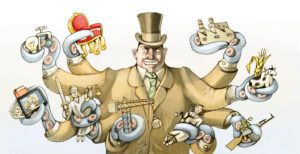The Permanent Temp Economy
A chronicle of the rise of temporary work, from World War II to the present, shows how corporations maximize profit by dumping employees from payrolls. A cluster of empty cubicles in a now-defunct office space in Portland, Oregon. (Asa Wilson / Flickr)(CC BY-SA 2.0)
A cluster of empty cubicles in a now-defunct office space in Portland, Oregon. (Asa Wilson / Flickr)(CC BY-SA 2.0)

Purchase in the Truthdig Bazaar
“Temp: How American Work, American Business, and the American Dream Became Temporary”
A book by Louis Hyman
The title of Louis Hyman’s book, “Temp: How American Work, American Business, and the American Dream Became Temporary,” gives a glimpse of the specificity readers will find in this meticulous chronicle of the rise of temporary work, from post World War II to the present. Hyman is a thorough and fair-minded guide through the evolution of attitudes toward labor and the resulting societal upheavals. Because he tracks the slow but steady trajectory toward the gig economy from its first steps in recessionary 1958, much of his research will be surprising to those who are not MBAs or labor historians.
The U.S. enjoyed about 25 years of economic growth and relative stability after the Second W
orld War, and the ’58 recession was short-lived. Still, it was that long ago that entrepreneur Elmer Winter began to publicly warn of the unlikely continuation of secure, full-time employment for all, and the perils of complacency that would descend on those failing to react to numerous signs threatening corporate vitality.At first, Winter promoted his idea of temporary workers for use in emergency situations only, seemingly savant about what Americans would accept and how quickly. He understood that cost cutting is more profitable than customer growth, and his low-overhead vision of supplying a wide array of businesses with temporary employees in all kinds of circumstances began to take hold in the early ’70s. Winter also correctly read the country’s consistently narrow regard for women; he had the nerve to build a business that for years employed mostly “white-gloved” women, and call it Manpower. (At intervals, Hyman reminds readers of our discriminatory workplace history, including New Deal policies that instituted essential worker protections, except for men of color and all women.)
“Temp” serves up micro and macro views of postwar business theory and history, as well. Exhaustive in detail, and sometimes repetitive, Hyman charts seesaw economic cycles, more common since the ’70s, that link to morphing feelings about immigration, unions and business itself. These cycles also connect to the changing composition of the U.S. workforce, and the waxing and waning of various business sectors. The ups and downs led not only to worker insecurity, but to anxious owners, shareholders, CEOs and managers of large companies. In turn, that anxiety led—implicitly, if not explicitly—to the establishment and insurgence of McKinsey & Co., the executive consultancy firm.
McKinsey would go on to assist businesses all over the U.S., and eventually the world, in planned restructuring based on the analysis and recommendations of outside consultants. As Hyman notes, “The terror of restructuring, while scary for workers, was good for the consulting business. As executives cut workforces, management consulting grew.” The threat of becoming obsolete drove consultancies based on abstract ideas onto the list of Forbes’ top moneymakers. (That consultancies have prospered so long seems to defy the notion of the visionary CEO. Is corporate success as unpredictable as that of scriptwriting, about which William Goldman notoriously claimed, “Nobody knows anything”? Admitting that would surely rumple C suite confidence.)
Click here to read long excerpts from “Temp” at Google Books.
“Temp” is also a story of how U.S. business went from risk averse to risk prone, as corporate attitudes veered toward behavior that might be described as greedy-as-you-can-get-away-with. Hyman relays a would-be cautionary tale about small businessman James Ling, who bought up companies—often in businesses he knew nothing about—and issued debt against their assets. He and his company of ever-changing names parlayed financial schemes and luck to gleefully grow, but their debt eventually got out of hand, like mold, and his shoot-the-moon conglomerate fell apart.
According to Hyman, Elmer Winter and Marvin Bower, longtime heads of Manpower and McKinsey respectively, operated and grew their companies differently, but both were as committed to their ideals and principles as they were to success. Their companies outlasted them, though, and in general, business culture’s shift toward risk acceptance aligns loosely with changes in corporate ethics.
As ethics became less of a priority in business behavior, doors to new ideas of how best to increase profits opened wider. Hyman covers the rotating trends—from conglomeration to growth matrix to reacceptance of monopolies—that defied John Kenneth Galbraith’s theory of corporate stability through measured profit growth. (Hyman quotes Galbraith: “Are the capitalist and communist industrial systems really sisters under the skin?” Ideologically committed free-marketeers might be appalled by this idea, but Galbraith’s analysis that markets and capitalism are incompatible as practiced proved prescient.)
Hyman refers to many companies and corporations like GE, AT&T, Intel, and Hewlett Packard throughout the book, but he utilizes Manpower, McKinsey & Co. and their leaders as his primary labor-altering examples. Apt choices, they pioneered idea and data-driven bottom line efficiency, and their target sectors and growth parallel the expansion of inequality in the U.S. (Manpower pertains to the worlds of low- and mid-skilled workers, and McKinsey to highly educated executives.) Both companies thrived on turnover, as they continue to today, despite crises and reinventions along the way, and the fact that copycat companies followed in their paths and grew even bigger.
As the turned pages mounted, drawing me closer to stories of today’s extreme have-and-have-not tech world, it was clear that most consultancy research pointed to the same finding: companies would maximize profit by getting rid of people and/or outsourcing jobs to pay people less for their work. Their language of leanness was less indelicate and changed over time, with differences in emphasis like the power of CEO talent. Nevertheless, dumping employees from payrolls was the trend that has proved unstoppable, and will continue. Of course, there are reasonable applications for experts and temporary workers, and decent arguments can be made that the safety net benefits of all citizens are not fairly borne by private businesses. But to live, people need decently paying jobs.
So what will happen? With his historian’s hat on, Hyman claims to be agnostic about the long arc toward the entrenchment of gig work, and documents it in epic detail. He then turns to brief hopeful nostrums for remaking the temp work life into one of pragmatic and humanistic opportunity. This is understandable; our culture demands hope even when few solutions are likely, or even seriously contemplated. To his credit, Hyman ventures possibilities that both conservatives and progressives could consider, the most promising of which look back to FDR. Few in power today have any interest in historical successes, however, and lean often is mean. Surviving looks as if it will become more like a music-less, too-few chairs brawl, as corporations slip further and further away from responsibility or connection to people and planet.
Reading “Temp,” I thought frequently of “Working,” Studs Terkel’s remarkable investigation into the trammeled soul of American workers. A paragraph from his introduction to the chronicle foretells a worry of these temporary times, too:
“Perhaps it is this specter that most haunts working men and women: the planned obsolescence of people that is of a piece with the planned obsolescence of the things they make. Or sell. It is perhaps this fear of no longer being needed in a world of needless things that most clearly spells out the unnaturalness, the surreality of much that is called work today.”
Your support is crucial...
As we navigate an uncertain 2025, with a new administration questioning press freedoms, the risks are clear: our ability to report freely is under threat.
Your tax-deductible donation enables us to dig deeper, delivering fearless investigative reporting and analysis that exposes the reality beneath the headlines — without compromise.
Now is the time to take action. Stand with our courageous journalists. Donate today to protect a free press, uphold democracy and uncover the stories that need to be told.







You need to be a supporter to comment.
There are currently no responses to this article.
Be the first to respond.